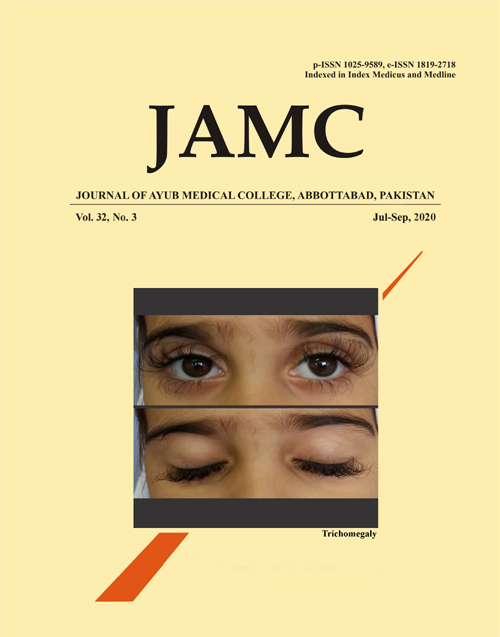RECONSTRUCTION OF SEGMENTAL MANDIBULAR LOSS WITH VASCULARIZED FREE FIBULA FLAPS
Abstract
Background: Various methods for mandibular reconstruction have been demonstrated in literature from autogenous bone graft to free flaps and more recently tissue engineered materials. We share our experience of mandibular reconstruction with free fibular flap and evaluate its efficiency as a viable option for mandibular reconstruction. Methods: It was a cross-sectional study, conducted at Plastic surgery department combined military hospital, Rawalpindi. Study was carried out over a period of two years from November 2016 to November 2018. The data of demography, mode of presentation, pattern of reconstruction and procedural complications of the patients who underwent free fibula flap for segmental mandibular loss, were collected and analysed. Patients with segmental loss of mandible ranging from 6 to 15 cm and those who could sustain surgery were included in the study, while the patients with metastatic malignancy and recurrent disease were excluded from the study. Each patient was called for first follow up after 2 weeks then subsequent follow up after 1 month. Descriptive statistics were done with the help of spss-20. Results: A total of 57 patients with segmental mandibular loss treated with free fibula flap, fulfilling inclusion and exclusion criteria were included in this study. Thirty-eight patients were male while 19 were female with mean age 56±3 years. Cause of mandibular loss was malignancy in 52 (91.2%), trauma in 3 (5.2%), and ameloblastoma in 2 (3.5%) patients. Major complications like flap failure was seen in one (1.75%), bone exposure in 1 (1.75%) and recurrence was observed in 1 (1.75%) patient. Minor complications like hematoma, wound dehiscence and oro-cutaneous fistula were seen in 2, 1 and 3 patients respectively. Conclusion: Free fibular flap shows good functional results with a high degree of consistency, and acceptable complications rate, so it should be the first choice for mandibular reconstruction.Keywords: Mandibular reconstruction; Free fibular flap; Osteo-Cutaneous FlapReferences
Kubein-Meesenburg D, Nägerl H, Schwestka-Polly R, Thieme KM, Fanghänel J, Miehe B. Functional conditions of the mandible: theory and physiology. Ann Anat 1999;181(1):27-32.
Kokosis G, Schmitz R, Powers DB, Erdmann D. Mandibular reconstruction using the free vascularized fibula graft: an overview of different modifications. Arch Plast Surg 2016;43(1):3-9.
Ahmed W, Asim MA, Ehsan A, Abbas Q. Non-vascularized autogenous bone grafts for reconstruction of maxillofacial osseous defects. J Coll Phys Surg Pak 2018;28(1):17-21.
Chen YC, Valerio IL, Chien CY, Jeng SF. Pedicled mandible myo-osseous flaps combined with free skin flaps for reconstruction of complex lateral mandibular defects. Head Neck 2012;34(3):384-92.
Pingarrón-MartÃn L, Otero TG, Gallo LA. Experience with mandibular reconstruction using transport-disc-distraction osteogenesis. Craniomaxillofac Trauma Reconstr 2015;8(2):117-22.
Rachmiel A, Shilo D, Blanc O, Emodi O. Reconstruction of complex mandibular defects using integrated dental custom-made titanium implants. Br J Oral Maxillofac Surg 2017;55(4):425-7.
Chanchareonsook N, Junker R, Jongpaiboonkit L, Jansen JA. Tissue-engineered mandibular bone reconstruction for continuity defects: a systematic approach to the literature. Tissue Eng Part B Rev 2013;20(2):147-62.
Disa JJ, Winters RM, Hidalgo DA. Long-term evaluation of bone mass in free fibula flap mandible reconstruction. Am J Surg 1997;174:503-6.
Goodacre TE, Walker CJ, Jawad AS, Jackson AM, Brough MD. Donor site morbidity following osteocutaneous free fibula transfer. Br J Plast Surg 1990;43(4):410-2.
Hidalgo DA. Fibula free flap: a new method of mandible reconstruction. Plast Reconstr Surg 1989;84(1):71-9.
Wei FC, Seah CS, Tsai YC, Liu SJ, Tsai MS. Fibula osteoseptocutaneous flap for reconstruction of composite mandibular defects. Plast Reconstr Surg 1994;93:294-304.
Hyder A, Sufyan A, Noor ul W, Huzaifa S ul K, Muhammad AG. The Osteomyocutaneous Free Fibula Flap in Mandibular Reconstruction. Interv Pediatr Dent Open Access J 2018;1(4):81431075.
Peled M, El-Naaj IA, Lipin Y, Ardekian L. The use of free fibular flap for functional mandibular reconstruction. J Oral Maxillofac Surg 2005;63(2):220-4.
Guerra MFM, GÃas LN, Campo FJR, González FJD. Vascularized free fibular flap for mandibular reconstruction: a report of 26 cases. J Oral Maxillofac Surg 2001;59(2):140-4.
Colletti G, Autelitano L, Rabbiosi D, Biglioli F, Chiapasco M, Mandalà M, et al. Technical refinements in mandibular reconstruction with free fibula flaps: outcome-oriented retrospective review of 99 cases. Acta Otorhinolaryngol Ital 2014;34(5):342-8.
Pellini R, Mercante G, Spriano G. Step-by-step mandibular reconstruction with free fibula flap modelling. Acta Otorhinolaryngol Ital 2012;32(6):405-9.
Bhuju KG, Xing S, Liu H. Evaluation of mandibular reconstruction with free vascularized fibular flap. J Nanj Med Univ 2008;22(1):23-7
Downloads
Published
How to Cite
Issue
Section
License
Journal of Ayub Medical College, Abbottabad is an OPEN ACCESS JOURNAL which means that all content is FREELY available without charge to all users whether registered with the journal or not. The work published by J Ayub Med Coll Abbottabad is licensed and distributed under the creative commons License CC BY ND Attribution-NoDerivs. Material printed in this journal is OPEN to access, and are FREE for use in academic and research work with proper citation. J Ayub Med Coll Abbottabad accepts only original material for publication with the understanding that except for abstracts, no part of the data has been published or will be submitted for publication elsewhere before appearing in J Ayub Med Coll Abbottabad. The Editorial Board of J Ayub Med Coll Abbottabad makes every effort to ensure the accuracy and authenticity of material printed in J Ayub Med Coll Abbottabad. However, conclusions and statements expressed are views of the authors and do not reflect the opinion/policy of J Ayub Med Coll Abbottabad or the Editorial Board.
USERS are allowed to read, download, copy, distribute, print, search, or link to the full texts of the articles, or use them for any other lawful purpose, without asking prior permission from the publisher or the author. This is in accordance with the BOAI definition of open access.
AUTHORS retain the rights of free downloading/unlimited e-print of full text and sharing/disseminating the article without any restriction, by any means including twitter, scholarly collaboration networks such as ResearchGate, Academia.eu, and social media sites such as Twitter, LinkedIn, Google Scholar and any other professional or academic networking site.









